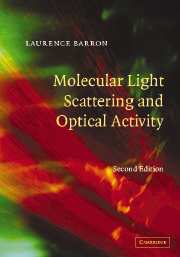Book contents
- Frontmatter
- Contents
- Preface to the first edition
- Preface to the second edition
- List of symbols
- 1 A historical review of optical activity phenomena
- 2 Molecules in electric and magnetic fields
- 3 Molecular scattering of polarized light
- 4 Symmetry and optical activity
- 5 Natural electronic optical activity
- 6 Magnetic electronic optical activity
- 7 Natural vibrational optical activity
- 8 Antisymmetric scattering and magnetic Raman optical activity
- References
- Index
5 - Natural electronic optical activity
Published online by Cambridge University Press: 07 August 2009
- Frontmatter
- Contents
- Preface to the first edition
- Preface to the second edition
- List of symbols
- 1 A historical review of optical activity phenomena
- 2 Molecules in electric and magnetic fields
- 3 Molecular scattering of polarized light
- 4 Symmetry and optical activity
- 5 Natural electronic optical activity
- 6 Magnetic electronic optical activity
- 7 Natural vibrational optical activity
- 8 Antisymmetric scattering and magnetic Raman optical activity
- References
- Index
Summary
A theory has only the alternative of being right or wrong. A model has a third possibility: it may be right, but irrelevant.
(Manfred Eigen)Introduction
This chapter is concerned with optical rotation and circular dichroism of visible and near ultraviolet light in the absence of an external influence such as a static magnetic field; in other words, natural optical activity in the electronic spectrum. Natural optical activity is generated by appropriate components of the molecular property tensors G′αβ and Aα,βγ which involve interference between an electric dipole transition moment and either a magnetic dipole or an electric quadrupole transition moment, respectively. Optical activity for light propagation along an arbitrary direction in a general anisotropic medium is complicated and is not considered here. We discuss only the most important situations in molecular optics; namely complete isotropy, as in a liquid or solution, and isotropy in the plane perpendicular to the direction of propagation. In the language of crystal optics, the latter situation is specified as light propagation along the optic axis of a uniaxial medium: it also corresponds to light propagation in the direction of a static field applied to an isotropic medium. As discussed in Section 4.4.4, in these situations the appropriate components of G′αβ and Aα, βγ are supported only by chiral molecules.
General aspects of natural optical rotation and circular dichroism
The basic equations
In Chapter 3, expressions for natural optical rotation and circular dichroism were derived using the refringent scattering approach.
- Type
- Chapter
- Information
- Molecular Light Scattering and Optical Activity , pp. 264 - 310Publisher: Cambridge University PressPrint publication year: 2004

